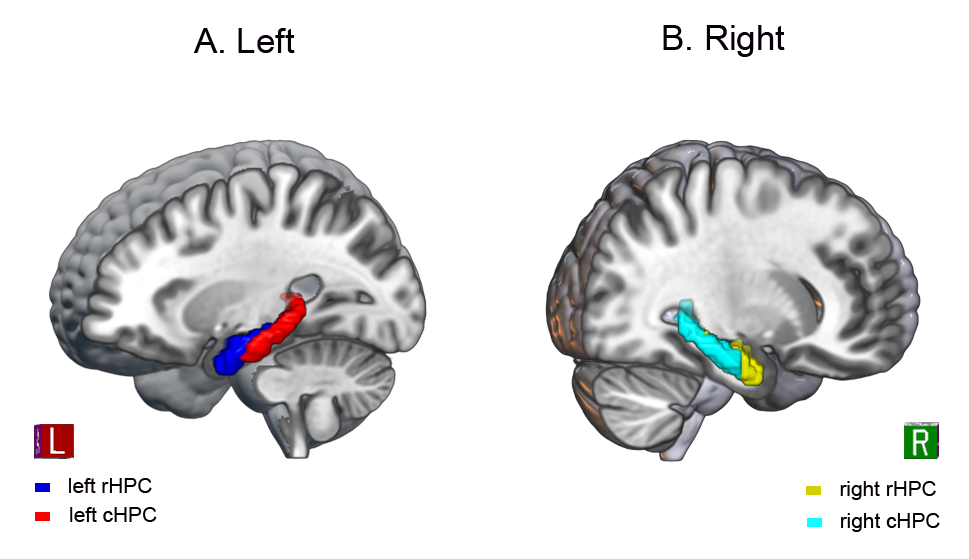拖延(Procrastination)是指“尽管个体会预期到不良后果,人们仍然自愿推迟开始或完成某一计划好的行为” (Steel, 2007)。拖延具有广泛的流行性,15%-20%的成年人存在慢性拖延,超出70%的学生承认自己存在学业拖延。研究证实,严重的拖延行为会削弱个体的学业、工作表现,甚至威胁其身心健康,比如加重心血管疾病等 (Sirois, 2015)。针对这一问题性行为,研究者指出,拖延行为的产生与负性情绪密切相关。短期情绪修复理论认为,拖延实质上是源于短期情绪修复的需要,具体而言,为了避免由任务厌恶所带来的焦虑等负性情绪的困扰,个体会选择以回避该任务进而达到修复暂时负性情绪的目的 (Sirois, 2013)。实证研究表明,特质焦虑越高的个人,越容易产生拖延行为(r= 0.34, p< 0.01; Constantin, 2018),因为特质焦虑的个体在压力环境下会感受到更强的焦虑情绪。然而,特质焦虑影响拖延的认知神经基础仍尚不清楚。
近日,学部冯廷勇教授团队在国际著名学术期刊Human Brain Mapping(中科院SCI二区,神经影像学top期刊)上,发表了题为“The anxiety-specific hippocampus–prefrontal cortex pathways links to procrastination through self-control”的学术论文。该研究发现:特质焦虑通过削弱个体的自我控制水平而增加拖延倾向。进而采用滑动时间窗(Sliding window method)的方法,分别以双侧海马亚区为种子点进行动态功能连接分析(见图1),结果发现特质焦虑水平与海马到前额叶通路的动态功能连接强度呈显著正相关关系(见图2),包括左侧喙部海马-左侧额上回(left rostral hippocampus- left superior frontal gyrus),和左侧喙部海马-右侧额中回(left rostral hippocampus- right middle frontal gyrus)。此外,结构方程模型分析发现,焦虑所特有的大脑神经环路(即海马到前额叶的连接通路)通过自我控制影响拖延行为。由此可见,焦虑者可能由于无法对负性思维实施有效的调控,进而产生更多的任务回避倾向。总之,本研究对于揭示特质焦虑影响拖延的认知神经基础具有重要的意义,为理解“为何焦虑的人会更加容易拖延“这一研究问题提供了新的视角。

图1. 种子点选取。双侧喙部海马、双侧尾部海马分别被定义为感兴趣区(Regions of Interest)。

图2. 特质焦虑的神经连接环路。
论文的第一作者为西南大学心理学部的博士研究生张荣,西南大学心理学部的冯廷勇教授为通讯作者。该研究得到国家自然科学基金面上项目(31971026)和中央高校基本科研业务经费创新团队项目(SWU2009104)支持。
文章索引
Zhang, R., Chen, Z., Hu, B., Zhou, F., & Feng, T. (2021). The anxiety-specific hippocampus–prefrontal cortex pathways links to procrastination through self-control. Human Brain Mapping, 1–11. https://doi.org/10.1002/hbm.25754
原文摘要
Procrastination, which is defined as delaying an intended course of action despite negative outcomes, is demonstrated to have a deal with negative emotion including trait anxiety. Although highly anxious individuals showed impoverished control ability, no studies have indicated the role of self-control in the relationship between trait anxiety and procrastination, and its neural correlates. To this end, we used the sliding window method to calculate the temporal deviation of dynamic functional connectivity (FC) in 312 healthy participants who underwent the resting-state functional magnetic resonance imaging (fMRI) scanning. In line with our hypothesis, higher trait anxiety is linked to more procrastination via poorer self-control. Besides, the dynamic FC analyses showed that trait anxiety was positively correlated with dynamic FC variability in hippocampus–prefrontal cortex (HPC–PFC) pathways, including left rostral hippocampus–left superior frontal gyrus (left rHPC–left SFG), and left rHPC–right middle frontal gyrus (left rHPC–-MFG). Furthermore, the structural equation modeling (SEM) uncovered a mediated role of self-control in the association between the anxiety-specific brain connectivity and procrastination. These findings suggest that the HPC–PFC pathways may reflect impoverished regulatory ability over the negative thoughts for anxious individuals, and thereby incurs more procrastination, which enhances our understanding of how trait anxiety links to procrastination.





